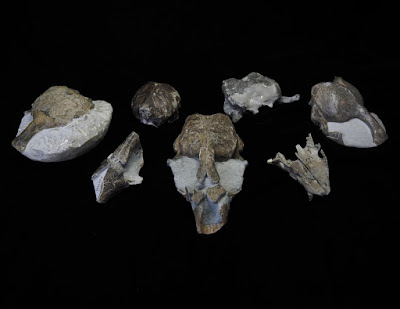 |
| Eomonachus belegaerensis Rule, Adams, Marx, Evans, Tennyson, Scofield & Fitzgerald, 2020 Illustration by Jaime Bran / Museum of New Zealand Te Papa. |
Abstract
Living true seals (phocids) are the most widely dispersed semi-aquatic marine mammals, and comprise geographically separate northern (phocine) and southern (monachine) groups. Both are thought to have evolved in the North Atlantic, with only two monachine lineages—elephant seals and lobodontins—subsequently crossing the equator. The third and most basal monachine tribe, the monk seals, have hitherto been interpreted as exclusively northern and (sub)tropical throughout their entire history. Here, we describe a new species of extinct monk seal from the Pliocene of New Zealand, the first of its kind from the Southern Hemisphere, based on one of the best-preserved and richest samples of seal fossils worldwide. This unanticipated discovery reveals that all three monachine tribes once coexisted south of the equator, and forces a profound revision of their evolutionary history: rather than primarily diversifying in the North Atlantic, monachines largely evolved in the Southern Hemisphere, and from this southern cradle later reinvaded the north. Our results suggest that true seals crossed the equator over eight times in their history. Overall, they more than double the age of the north–south dichotomy characterizing living true seals and confirms a surprisingly recent major change in southern phocid diversity.
Keywords: Monachini, biogeography, Taranaki, phylogeny, Monachinae, fossil
James P. Rule, Justin W. Adams, Felix G. Marx, Alistair R. Evans, Alan J. D. Tennyson, R. Paul Scofield and Erich M. G. Fitzgerald. 2020. First Monk Seal from the Southern Hemisphere rewrites the Evolutionary History of True Seals. Proceedings of the Royal Society. DOI: 10.1098/rspb.2020.2318
The new species is named Eomonachus belegaerensis, (meaning 'dawn monk seal from Belegaer') after the sea of Belegaer, which lies west of Middle Earth in J.R.R. Tolkien's Lord of the Rings.
New fossil seal species rewrites history




